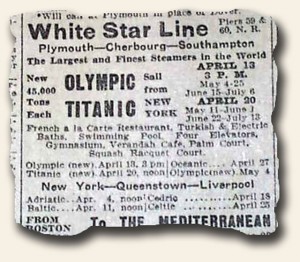Period printing… Did you ever notice…?
April 30, 2012 by GuyHeilenman · 1 Comment
A few months ago we received an inquiry from one of our friends wondering why pre-1900 newspapers included a period after the newspaper’s title in the masthead. While I hold hundreds of such issues in my hands each week, I had never taken notice of this. Wondering if this was in fact the case, I quickly began searching through our 19th and 18th century archives, and low and behold, every title ended with a period. Searching through our 20th century inventory I discovered that none of the issues did. I asked Tim Hughes his thoughts on the matter, and his response was as follows:
Regarding the query about periods at the end of 19th century titles, I don’t believere there is a reason beyond it simply being the grammatical style of the  period. In fact the practice goes back to the 17th and 18th centuries as well. It was just the way newspapers (and magazines) were laid out, perhaps following some sort of grammatical “rule” of the day. There was also–compared to today–an excessive use of commas within text, which again was just the style of the day.
period. In fact the practice goes back to the 17th and 18th centuries as well. It was just the way newspapers (and magazines) were laid out, perhaps following some sort of grammatical “rule” of the day. There was also–compared to today–an excessive use of commas within text, which again was just the style of the day.
Perhaps the more interesting question would be when & why was the period eliminated at some point in the 20th century? I would suspect one paper just made the decision and everyone else eventually followed, as there was much competition and copying among newspapers. Sorry I don’t have a more intriguing answer!
If any of our readers have additional information in regards to this, feel free to respond.
Robert E. Lee… a touching tribute…
April 27, 2012 by GuyHeilenman · 3 Comments
Buried deep within a September 3, 1868 issue of The New-York Times is a touching tribute to Robert E. Lee. This, along with several other articles from throughout the newspaper, provide a glimpse of this difficult post-Civil War period – with Nathan Bedford Forrest’s interview, the tension over support for Ulsysses S. Grant’s run for the Presidency, and reports from both the Republic and Democratic Party’s conventions providing the backdrop for this almost overlooked intimate letter from the editor of the Fredericksburg News.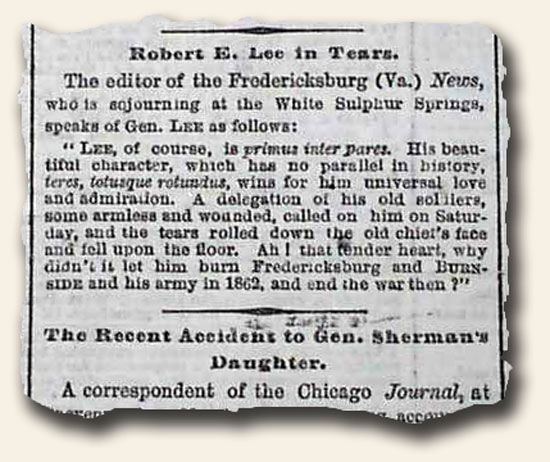
Virginia’s first newspapers… and much more.
April 23, 2012 by TimHughes · Leave a Comment
With the focus of today’s post being the first newspapers in Virginia, I discovered that the story as told by the existing “Virginia Gazette”, at www.vagazette.com provides a thorough, interesting and well-written documentation on not just Virginia’s first newspaper but all early printing of news in Virginia. So it is to to them that we give credit for the following:
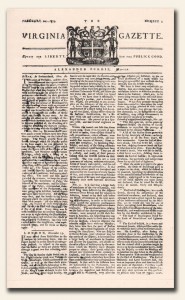 If there is nothing as fragile as news, the fragility of newspapers themselves runs a close second. Hundreds of newspapers have begun with great ambition, only to merge with others or fold from bankruptcy.
If there is nothing as fragile as news, the fragility of newspapers themselves runs a close second. Hundreds of newspapers have begun with great ambition, only to merge with others or fold from bankruptcy.
With that knowledge, William Parks might be the most astonished person of all to learn that his “Virginia Gazette” survives intact nearly 270 years after he published the first four-page edition on Aug. 6, 1736.
Newspapers were a long time coming to colonial Virginia. English law precluded any printing by the colonists for years after Jamestown was founded in 1607. The royal governors did not allow any printing until 1690, and even then printers were governed by royal instructions which required a license and the governor’s permission.
One of those governors, Sir William Berkeley, put it bluntly. “I thank God, there are no free schools nor printing, and I hope we shall not have these hundred years; for learning has brought disobedience, and heresy, and sects into the world, and printing has divulged them, and libels against the best government. God keep us from both.”
An enterprising fellow tried anyway.
In 1682, a printer named William Nuthead arrived at Jamestown, then the capital. He set up his press and began to publish the acts of the recently adjourned Assembly. He also printed several other papers about which nothing is known.
Nuthead was called before the governor and the council, where he was ordered to stop the presses “until the signification of his Majesties pleasure shall be known therein.” Within months that “pleasure” was known when a royal order was issued that “no person be permitted to use any press for printing upon any occasion whatsoever.”
With that definitive ruling, Nuthead packed up and returned to his native Maryland. Printing was nonexistent in the colony for nearly 50 years thereafter.
Government policy eventually eased and a more tolerant attitude prevailed. In 1730 William Parks moved from Annapolis to Virginia’s new capital, Williamsburg, to open a branch office. Parks had only three years earlier founded Maryland’s first newspaper, “The Maryland Gazette”.
Parks was an eminent printer. Before arriving in Maryland he operated printing shops in three locations of his native England – Ludlow, Hereford and Reading.
Parks had an effect on Williamsburg. Right from the start his Gazette had the professional touch of a master craftsman. News in the Gazette was taken largely from letters written abroad and recently arrived in the hands of the printer himself or friendly readers. Information was also taken from English papers and other colonial sheets.
There was not much local news in Parks’ Gazette. What little there was appeared primarily in advertisements of recent ship arrivals, shops opening, runaway slaves, deserted spouses, and strayed horses.
By today’s standards The Virginia Gazette of 1736 would look gray and ponderous. There were no headlines, no photographs, no fancy page makeup. But there was news, and for a town that never had a newspaper before it was welcome.
A typical day for William Parks had him working ten hours, perhaps more if he was printing his weekly Gazette on his sheet-fed handpress. It was a laborious process of setting the type by hand, picking letter by letter from a box of matrices.
Once the type was set it was locked into place in a metal form. The type was inked and paper was laid across. The form was rolled into the press, where the pressman “pulled” an impression by yanking with both arms the big handle of the press. This pressure forced the press to screw down on the paper and imprint the type on the paper sheet. Around 200 sheets an hour were printed this way, then hung to let the ink dry.
Hours were dictated largely by daylight, although some type was composed by candlelight. This led to errors and an occasional mishap in which trays of painstakingly set type were “pied” or spilled.
Colonial printers were hampered by a scarcity of type that slowed the printing of books because only a few pages could be set at a time before the letters were reused.
Weather frustrated many a printer, Parks included. Winter cold slowed the mails on which the Gazette was so dependent for news. When no dispatches arrived, Parks would offer that as an excuse for printing a shorter sheet. Spring and fall were the busy time during which the General Court convened in Williamsburg. Summer and winter were comparatively dull, and this is reflected in the Gazettes of the period.
Censorship also posed problems, and from three sectors: the English government, local authorities, and an offended public.
The last major problem faced by colonial printers was a shortage of paper. This was handmade stuff, consisting of ground-up rags. It was tough and durable but varied in quality. In 1743 at the urging of Benjamin Franklin, Parks set about building his own paper mill in Williamsburg. Over the next four years Franklin sold Parks 11,382 pounds of rags. Appeals were often printed asking readers to save their old clothes for paper-making purposes. Old shirts, caps, dresses, handkerchiefs and gowns were brought and subsequently returned to the reader in a different form.
In early 1750 Parks sailed for England on a business trip. During the voyage he was seized with a fatal attack of pleurisy and was buried at journey’s end in Gosport, England.
The stature of William Parks in journalism history can be measured in part by the number of “firsts” to his credit:
- First newspaper in Maryland.
- First public printer in Virginia.
- First newspaper in Virginia.
- First publications of literary works in Virginia.
- First paper mill south of Pennsylvania.
- First postmaster of Virginia.
Following the death of William Parks in 1750, his associate in business, William Hunter, bought the printing shop and with it the Gazette. Hunter went on to distinguish himself in the tradition of William Parks.
He served jointly with Benjamin Franklin as deputy postmaster general for all the colonies. He also printed in 1754 the first published writings of George Washington, “The Journal of Major George Washington,” who at the time was 22 years old.
If there ever was a heyday for newspapers in Virginia and Williamsburg, it was during the Revolution. Albeit partisan, The Virginia Gazette and other colonial newspapers reported well the news of the growing unrest between the Crown and the colonies.
Fully 10 years before the Declaration of Independence, there appeared carefully worded accounts. The repeal of the Stamp Act in March 1766 brought great rejoicing to the colonies and was covered locally in The Virginia Gazette on June 20, 1766.
“On Friday last, a good deal of Company being in Town at the Oyer and Terminer Court, our Gratitude and Thankfulness upon the joyful Occasion of the Repeal of the Stamp Act and the universal Pleasure and Satisfaction it gives that all Differences between the Mother Country and her Colonies are so happily terminated, was manifested here by general illuminations…”
Hunter died in 1761 and was succeeded by another brother-in-law, Joseph Royle. Hunter’s will stipulated that Royle manage the business for himself and Hunter’s infant son, William Hunter Jr.
At the urging of Thomas Jefferson and others, William Rind moved from Annapolis in 1766 to set up a rival Virginia Gazette. Jefferson recalled years later that “…we had but one press, and that having the whole business of the government, and no competitor for public favor, nothing disagreeable to the governor could be got into it. We procured Rind to come from Maryland to publish a free paper.”
Rind was elected public printer by the House of Burgesses, giving him an economic foothold in the form of printing documents and laws. As it turned out, the Assembly three years later spread the wealth to both Gazettes when it ordered them to print a large volume of the Acts of Assembly then in force.
Alexander Purdie succeeded Joseph Royle as publisher of the original Virginia Gazette. In 1767, Purdie took into the business John Dixon, who by marriage was related to Royle’s widow. Purdie, dissatisfied with the partnership, withdrew to set up his own Virginia Gazette. The first issue appeared Feb. 3, 1775.
If the reader is confused, imagine how confused Williamsburg readers were 200 years ago. By early 1775 there were three separate Virginia Gazettes, all operating in town and all under the same name.
There was Dixon’s Gazette (the original), Rind’s Gazette and Purdie’s Gazette (the newest). They all carried pretty much the same news in largely the same format, four to eight pages weekly. The easiest way to tell them apart was by their mottos. The original Gazette was known to be “Containing the freshest Advices, Foreign an Domestick.” Rind’s Gazette promised it was “Open to all Parties but Influenced by None.” Purdie’s declared “Always for Liberty and the Publick Good.”
Nor were these three the only Virginia Gazettes. By 1809 a total of 24 papers in the state had used the term Virginia Gazette in their flags. The reason is simple. “Gazette” in Britain specified “official record” and lent real authority to any periodical with that name. In the colonies, the Assemblies ordered their resolutions and proclamations printed “in the Gazette” or “in The Virginia Gazette” for public attention and consumption.
But it was not specified which Gazette was to get the business, leaving it up for grabs in Williamsburg among three papers. A printer calling his paper, say, The Williamsburg Bugle, was automatically eliminating himself from any government income.
Rind’s paper was taken over upon his death in 1773 by his wife, Clementina. She thus became the first woman printer and editor in Virginia, and is credited by at least one historian as one of the 10 pioneer women journalists in America.
By 1775 John Pinkney took over as manager and then in 1776 as owner of Mrs. Rind’s shop and paper, but he moved to North Carolina early in 1777 and died in August that year. This marked the end of the second Virginia Gazette.
The third Gazette operated by Alexander Purdie continued after his death in 1779. His nephew, John Clarckson, and one of his printers, Augustine Davis, ran it until the end of 1780 when it ceased operations because the capital had moved.
Purdie’s Gazette continued to be a sparkling newspaper after it was formed anew in 1775 and Dixon was left with the original Gazette. Perhaps because Dixon’s new partner, William Hunter Jr., was a loyalist, the original Gazette dragged its feet on covering the Revolution. In any event, Purdie continually scooped the other two Gazettes.
On Feb. 2, 1776, Purdie printed excerpts from Tom Paine’s pamphlet, “Common Sense,” the famous statement of arguments for independence. John Pinkney ran it the next day in his Virginia Gazette.
Reporting the Declaration of Independence
Purdie also beat the competition on breaking the Declaration of Independence. He published a brief reference to it by way of the postmaster in Fredericksburg on July 12, just 10 days after Congress resolved that the united colonies were free and independent states. (It wasn’t declared until July 4.)
The following Friday, July 19, Purdie ran key passages from the Declaration, promising to print the entire document next week. Dixon and Hunter followed suit and the two Gazettes ware thought to be the first papers outside Philadelphia to print the Declaration verbatim.
What’s curious is how the two Gazettes played it up – or down. Purdie ran it as lead story on Page 1, which it consumed entirely before concluding atop page 2. There were also reports on the proclamation of the Declaration in Trenton, New York and Williamsburg.
Dixon and Hunter, on the other hand, ran the Declaration on Page 2, reserving Page 1 for lesser accounts about shipping, naval matters and a death. (Pinkney’s Gazette didn’t run it at all – it had folded the previous February.)
No one knew during these troubled times what the outcome of the Revolution would be. But the Gazettes and the other 34 colonial newspapers reported the excesses of the British government and the steps taken by the colonists to guarantee their own freedoms.
More than the political pamphlet and more than the sermons by political clergy, the colonial newspaper contributed the most to the propaganda of the Revolution. The Patriot press inspired the colonies to rebel against tyranny, and it worked.
Southern Illustrated News images on Pinterest…
April 20, 2012 by GuyHeilenman · 2 Comments
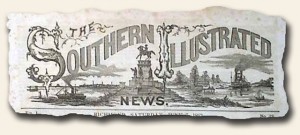 The Southern Illustrated News (Richmond, Virginia) was the Confederate counterpart to Harper’s Weekly Illustrated (NY, New York). While its distribution and duration were limited, the issues have become quite collectible. Portraits of Stonewall Jackson, Robert E. Lee, John S. Mosby, J.E.B Stuart, John H. Morgan, along with nearly every other notable figure from the Confederacy adorned the front page of this highly sought-after publication. Rare & Early Newspapers has taken on the task of posting images of every issue on Pinterest. While this project may take years, feel free to enjoy the progress to-date at: The Southern Illustrated News on Pinterest.
The Southern Illustrated News (Richmond, Virginia) was the Confederate counterpart to Harper’s Weekly Illustrated (NY, New York). While its distribution and duration were limited, the issues have become quite collectible. Portraits of Stonewall Jackson, Robert E. Lee, John S. Mosby, J.E.B Stuart, John H. Morgan, along with nearly every other notable figure from the Confederacy adorned the front page of this highly sought-after publication. Rare & Early Newspapers has taken on the task of posting images of every issue on Pinterest. While this project may take years, feel free to enjoy the progress to-date at: The Southern Illustrated News on Pinterest.
Topsy the elephant… Thomas Edision vs. Nikola Tesla…
April 18, 2012 by GuyHeilenman · Leave a Comment
 Each day at Rare Newspapers brings new discoveries. Today we found an item which is quite historic. In 1903, the battle between Thomas Edison and Nikola Tesla (and Westinghouse) as to which form of electrical current (DC or AC) was to become the standard, was largely decided – with Edison’s DC current being the loser. Not willing to give up without a fight, Edison attempted to win public and political support by stressing the greater danger of death by electrocution from contact with AC current. In a highly publicized dramatic event, Edison organized and helped supervise the filming and electrocution by AC current of Topsy, a Coney Island circus elephant which had recently killed three men. While the execution was successful, and was overseen by the Society for Prevention of Cruelty to Animals, Edison was highly criticized for the event which did not accomplish his desired goal. The report was found on the front page of the ALLEGHENY COUNTY REPORTER, Wellsville, New York, January 6, 1903. I wonder if the S.P.C.A. would support such an action today?
Each day at Rare Newspapers brings new discoveries. Today we found an item which is quite historic. In 1903, the battle between Thomas Edison and Nikola Tesla (and Westinghouse) as to which form of electrical current (DC or AC) was to become the standard, was largely decided – with Edison’s DC current being the loser. Not willing to give up without a fight, Edison attempted to win public and political support by stressing the greater danger of death by electrocution from contact with AC current. In a highly publicized dramatic event, Edison organized and helped supervise the filming and electrocution by AC current of Topsy, a Coney Island circus elephant which had recently killed three men. While the execution was successful, and was overseen by the Society for Prevention of Cruelty to Animals, Edison was highly criticized for the event which did not accomplish his desired goal. The report was found on the front page of the ALLEGHENY COUNTY REPORTER, Wellsville, New York, January 6, 1903. I wonder if the S.P.C.A. would support such an action today?
The Traveler… a sad headline day…
April 16, 2012 by The Traveler · Leave a Comment
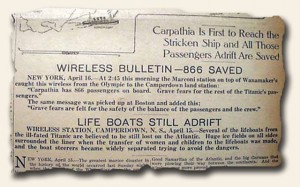 Today I found myself in a period of time that is so familiar to all that unfortunately not much really needs to be written about it. The Tribune, Los Angeles, April 16, 1912, reported the sad headline of “Titanic Sinks; 675 Are Saved 1800 Go Down In Ship, Report” and contains many reports, photos, illustrations, and passenger lists. While I have spent most of my travels looking for the off-the-beaten-path articles/news of the day, some days the main event is so tragic, to look for anything trivial would be inappropriate.
Today I found myself in a period of time that is so familiar to all that unfortunately not much really needs to be written about it. The Tribune, Los Angeles, April 16, 1912, reported the sad headline of “Titanic Sinks; 675 Are Saved 1800 Go Down In Ship, Report” and contains many reports, photos, illustrations, and passenger lists. While I have spent most of my travels looking for the off-the-beaten-path articles/news of the day, some days the main event is so tragic, to look for anything trivial would be inappropriate.
~The Traveler
If at first you don’t succeed…
April 13, 2012 by GuyHeilenman · Leave a Comment
A post-Civil War issue of the New York Herald, October 2, 1865, had an interesting article regarding a young lady who was determined to elope… and the lengths her parents undertook to retrieve her… on more than one occasion. Perhaps the 3rd time will be the charm. Please enjoy:
The Titanic… and newspapers…
April 11, 2012 by TimHughes · 2 Comments
Few newspapers in 20th century world history are more desired that those which report the sinking of the Titanic. The combination of the scale of the tragedy, it being the maiden voyage of the world’s largest ship, it claiming to be unsinkable, and the loss of some of the wealthiest & more famous names in America, all combine to make for a desirable event. And add to this the tremendous success of the 1997 movie and interest explodes. We find that interest is piquing once more with the re-release of the successful movie, which begs the question: Just what do collectors desire most in this report?
From comments by collectors and what they pay for the best we have offered through the years, the “best of the best” would include:
* As huge a headline as possible. Type with letters 3 issues tall are more dramatic & displayable than those with letters half an inch tall.
* The words “Titanic” and “Sunk” somewhere within the headline. The more dramatic the headline the better.
* A banner headline–which stretches from edge to edge–rather than a two column headline. For many newspapers that was simply not their format. But banner heads have always been more desired than small headlines.
* Not necessarily first reports. Many reports dated April 15 tended to have sketchy reports, smaller headlines, and inaccurate statements. Several noted that the Titanic was being safely towed into port. Issues dated April 16–when more accurate information was known–tended to be not only more historically correct but more dramatic as well.
* Best condition possible. Those which came from bound volumes tend to be in great condition since they were protected within the volume for 100 years. Never-bound issues tend to suffer from wear and staining.
* Complete issues only. Front pages only might be fine for display but maximum desirability is only for issues with all published pages.
* A graphic. Some newspapers used a pre-existing photo of the Titanic. But of more interest are artists’ renditions of what the sinking may have looked like. Some were very dramatic. The larger the better.
* Famous titles such as the New York Times, Chicago Tribune, etc. tend to have more desirability, but a dramatic presentation will always trump a famous title.
Note: To view a selection of Titanic disaster headlines on Pinterest, go to:
The Titanic Sinks – Historic Newspapers
Happy Passover… Happy Easter…
April 6, 2012 by GuyHeilenman · Leave a Comment
President George Washington is known for his letters to various Hebrew congregations (Newport, Savannah, etc.) and churches which are filled with spiritual references. Considering the recipients, such language might be expected even if the writer was not a person of faith. However, the following is a speech he gave to the leaders of Philadelphia upon his visit to the city while in transit to New York to take the oath of office. At a time when he could have said anything, what he chose to say and how he chose to say it speaks volumes. Please enjoy his address as it appeared in The Massachusetts Centinel, May 2, 1789: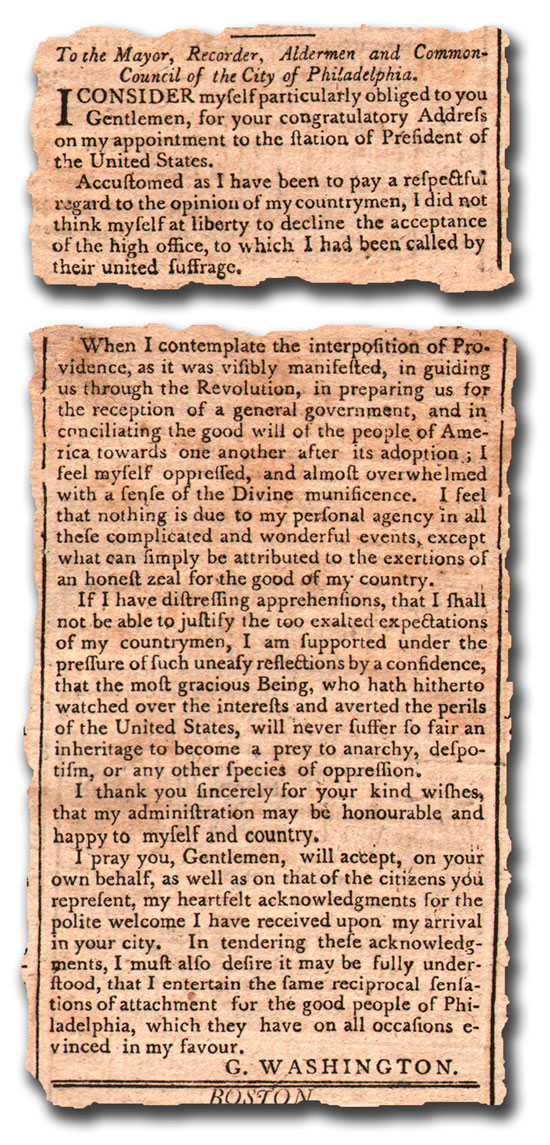
The Traveler… the Czar gets married… loose lips…
April 2, 2012 by The Traveler · 1 Comment
Today’s travels took me to The London Gazette of April 5, 1712 where I found the Czar of Mosco (Moscow) has publicly solemnized his wedding with his Empress  Catherina Alexewna. The wedding had to be deferred for some time by reason his Czarish Majesty’s “making the Campaign the last Summer.” The article provides details of the wedding.
Catherina Alexewna. The wedding had to be deferred for some time by reason his Czarish Majesty’s “making the Campaign the last Summer.” The article provides details of the wedding.
Another article on the front page is of the Suedes (Swedes) making advancement into Pomerania before the Danes could hinder them. Two officers of the Swedish Fleet had been condemned “to have their Heads struck off, for having held a Correspondence with the Danes, and their Father, who was privy to these Actions of his Sons, and did not discover them, is confin’d to a perpetual Imprisonment…” There are times it is just better to keep the lips sealed. Whereas some have been known to sink ships, this is even worse…
~The Traveler



